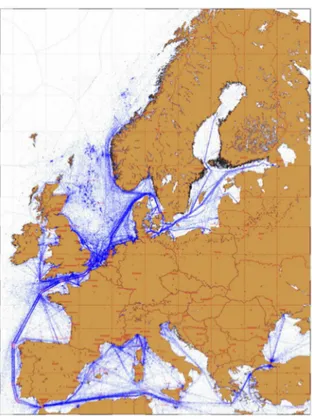Introduction
- 1 -
Introduction
Each year, ships and industries are damaging the delicate coastal ecosystem in many parts of the world, releasing oil or pollutants into rivers and coastal waters. The offshore environments are also polluted by mineral oil, mainly for the following reasons:
• tanker incidents at sea, where large amounts of oil are spilled into the sea;
• illegal oil discharges from vessels, during their “normal operating procedures” (i.e., oil dumped during cleaning operations);
• natural oil seepage.
After a tanker accident, the biggest problems encountered are the difficulty in obtaining an overall view of the affected area, getting a clear idea of the extent of the slick, and predicting the direction in which it will move. For natural oil spills and those caused by humans, it is necessary to plan a regular monitoring programme. The aerial surveys over large areas (e.g., the Mediterranean Sea) to check the presence of oil are limited to daylight and good weather conditions.
The Mediterranean Sea is characterized by an extensive marine traffic (see fig. Int.2) because it provides maritime access to the Middle East (and the Suez Canal), the Black Sea and Southern Europe. Much of this traffic is caused by oil tankers. This high level of traffic creates a high risk of pollution and even ecological disaster, made worse by the fact that the Mediterranean is a closed sea, and that the pollutants cannot be diluted over a larger area by ocean currents.
Oil pollution monitoring in the Mediterranean Sea is normally carried out by aircraft or ships. This is expensive, and is constrained by the limited availability of these resources. The satellite imagery can provide a significant contribution in this field, identifying probable spills over very large areas, then guiding aerial surveys for precise observations of specific locations.
Ocean pollution by oil slicks remains a major environmental hazard. Oil tanker accidents (such as Exxon Valdez, Erika, and Prestige), although spectacular and highlighted, only account for 5% of total oil pollution
Fig. Int.1: Ship dumping sewage in the North Sea.
Introduction
- 2 - worldwide, 95% coming from illegal discharges [16]. In order to provide all-weather and global monitoring of such events, spaceborne Synthetic Aperture Radar (SAR) has been recognized as a cornerstone. This instrument offers the most effective means of monitoring oil pollution. Oil slicks appear as dark patches in SAR images because the presence of an oil film dampens sea capillary waves, thus the backscattering is reduced. This results in oil polluted areas appearing darker than clean waters in radar images. The sea appears less rough in these areas, and the backscattering is reduced. Hence, such an area would appear darker in a radar image.
Automatic detection of oil spill in SAR images has been a wide field of research in the last years, much effort being dedicated to the classification of oil spill candidates (i.e., dark patches in the SAR image). This thesis work belongs to the DESPOS project (Exploitation of COSMO-SkyMed system for Detection of Ships resPonsible of Oil Spills) that aims to define a technique for the detection of the responsible ships of oil spills by taking advantage of the short revisit time of the COSMO-SkyMed (CSK) constellation (up to 2.5 hours on average). To make it possible to identify these oil spills and to correlate them to the detected ships at the same instant, after and/or before the passages of the CSK satellites, offering a tool to support inspection and monitoring activities aimed to identify illegal actions in which oil tankers are involved.
Many ocean surface signatures in SAR imagery are characterized by relatively low normalized radar cross section values. Distinguishing among these signatures objectively can be very difficult, especially with only the single-band and single-polarization SAR imagery. An algorithm in MATLAB has been developed, employing a fractal spectral characterization of the sea surface, in particular by means of the Fractionally Integrated Autoregressive Moving Average (FARIMA) and Fractionally EXPonential (FEXP) models for the Power Spectral Density (PSD) as a wave number function. The proposed technique will be capable of detecting oil spills using conventional and innovative algorithms to recognize and discriminate these one from other phenomena (look-alikes). Only two parameters belonging
Fig. Int.2: Cumulated ship detection reports. Generated by © CLS, using ENVISAT/ASAR products. ©ESA (2002-2009).
Introduction
- 3 - to the models are necessary for the classification, making the algorithm faster with a very low computational load.
The thesis is organized as follows.
In Chapter 1 the sea surface, the rough surface scattering and look-alike phenomena are examined.
In Chapter 2 a short view about the COSMO-SkyMed system is made, in particular the instrument functions, the acquisition mode characteristics, the system performances and the images under test are described.
In Chapter 3 the techniques for speckle noise reduction and the segmentation algorithm for detecting dark patches in the scene are described.
Chapter 4 describes how to recognize and discriminate these dark patches. In particular the FARIMA, FEXP model and the classification algorithm are introduced, including an analysis about the sea surface spectra, since this is the first step for the application of the above mentioned models.
In Chapter 5 the experimental results of the application of the described techniques to the images under test are shown.
